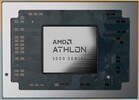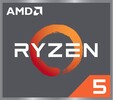AMD Athlon Silver 3050U vs AMD Ryzen 5 3500U
AMD Athlon Silver 3050U
► remove from comparison
The AMD Athlon Silver 3050U is a mobile processor for thin and light entry level laptops. It is based on the Picasso series (e.g. Ryzen 3000U APUs) and offers two Zen cores clocked at 2.3 to 3.2 GHz without SMT (two threads at once) and 4 MB of L3 Cache. The integrated graphics card is called Radeon RX Vega 2 and offers only 2 CUs (128 shaders) clocked at up to 1,100 MHz.
In Chromebooks, AMD calles the APU AMD Athlon Silver 3050C, but with the exact same specifications (and performance).
Performance
We have not tested a single system built around the 3050U, as of August 2023. Expect the chip to be just a few percentage points slower than the Athlon 3150U (two Zen cores, 4 threads, up to 3.3 GHz). This kind of performance should suffice for most day-to-day tasks but not much more than that.
Power consumption
This Athlon series chip has a default TDP of 15 W (also known as the long-term power limit). Laptop makers are free to change that to anything between 12 W and 25 W with clock speeds and peformance changing accordingly as a result. Either way, that's a tad too high to allow for passively cooled designs.
Last but not the least, the APU is built with a 14 nm process leading to poor, as of early 2023, energy efficiency.
AMD Ryzen 5 3500U
► remove from comparison
The AMD Ryzen 5 3500U is a mobile SoC that was announced in January 2019. It combines four Zen+ cores (8 threads) clocked at 2.1 GHz to 3.7 GHz with a Radeon RX Vega 8 iGPU with 8 CUs (512 Shaders) clocked at up to 1200 MHz. Specified at 15 Watt TDP, the SoC is intended for thin mid-range laptops. In Chromebooks, AMD calles the APU AMD Ryzen 5 3500C, but the specifications (and performance) are the same.
The Picasso SoC uses the Zen+ microarchitecture with slight improvements that should lead to a 3% IPS (performance per clock) improvements. Furthermore, the 12 nm process allows for higher clocks at similar power consumption.
The integrated dual-channel memory controller supports up to DDR4-2400 memory. As the features of the Picasso APUs are the same compared to the Raven Ridge predecessors, we point to our Raven Ridge launch article.
Performance
The average 3500U in our database matches the Intel Core i7-1065G7 in multi-thread performance to be an OK lower mid-range option, as of early 2021.
The Honor MagicBook 14 is among the fastest laptops powered by the 3500U that we know of. It can be up to 50% faster in CPU-bound workloads than the slowest system featuring the same chip in our database, as of August 2023.
Power consumption
This Ryzen 5 series chip has a default TDP (also known as the long-term power limit) of 15 W, a value that laptop makers are free to set to anything between 12 W and 35 W with clock speeds and performance changing accordingly as a result. Either way, this is a tad too high to allow for passively cooled designs.
The chip is manufactured on a 12 nm process for subpar, as of late 2022, energy efficiency.
| Model | AMD Athlon Silver 3050U | AMD Ryzen 5 3500U | ||||||||||||||||||||||||||||||||
| Codename | Dali (Zen) | Picasso-U (Zen+) | ||||||||||||||||||||||||||||||||
| Series | AMD Picasso (Ryzen 3000 APU) | AMD Picasso (Ryzen 3000 APU) | ||||||||||||||||||||||||||||||||
| Series: Picasso (Ryzen 3000 APU) Picasso-U (Zen+) |
|
| ||||||||||||||||||||||||||||||||
| Clock | 2300 - 3200 MHz | 2100 - 3700 MHz | ||||||||||||||||||||||||||||||||
| L1 Cache | 192 KB | 384 KB | ||||||||||||||||||||||||||||||||
| L2 Cache | 1 MB | 2 MB | ||||||||||||||||||||||||||||||||
| L3 Cache | 4 MB | 4 MB | ||||||||||||||||||||||||||||||||
| Cores / Threads | 2 / 2 | 4 / 8 | ||||||||||||||||||||||||||||||||
| TDP | 15 Watt | 15 Watt | ||||||||||||||||||||||||||||||||
| Transistors | 4500 Million | 4500 Million | ||||||||||||||||||||||||||||||||
| Technology | 14 nm | 12 nm | ||||||||||||||||||||||||||||||||
| max. Temp. | 95 °C | 105 °C | ||||||||||||||||||||||||||||||||
| Socket | FP5 | FP5 | ||||||||||||||||||||||||||||||||
| Features | DDR4-2400 RAM, PCIe 3, MMX, SSE, SSE2, SSE3, SSSE3, SSE4A, SSE4.1, SSE4.2, AVX, AVX2, BMI2, ABM, FMA, ADX, SMEP, SMAP, CPB, AES-NI, RDRAND, RDSEED, SHA, SME | DDR4-2400 RAM, PCIe 3, MMX, SSE, SSE2, SSE3, SSSE3, SSE4A, SSE4.1, SSE4.2, AVX, AVX2, BMI2, ABM, FMA, ADX, SMEP, SMAP, SMT, CPB, AES-NI, RDRAND, RDSEED, SHA, SME | ||||||||||||||||||||||||||||||||
| iGPU | AMD Radeon RX Vega 2 ( - 1100 MHz) | AMD Radeon RX Vega 8 (Ryzen 2000/3000) ( - 1200 MHz) | ||||||||||||||||||||||||||||||||
| Architecture | x86 | x86 | ||||||||||||||||||||||||||||||||
| Announced | ||||||||||||||||||||||||||||||||||
| Manufacturer | www.amd.com | www.amd.com |
Benchmarks
Average Benchmarks AMD Athlon Silver 3050U → 100% n=2
Average Benchmarks AMD Ryzen 5 3500U → 171% n=2
* Smaller numbers mean a higher performance
1 This benchmark is not used for the average calculation













